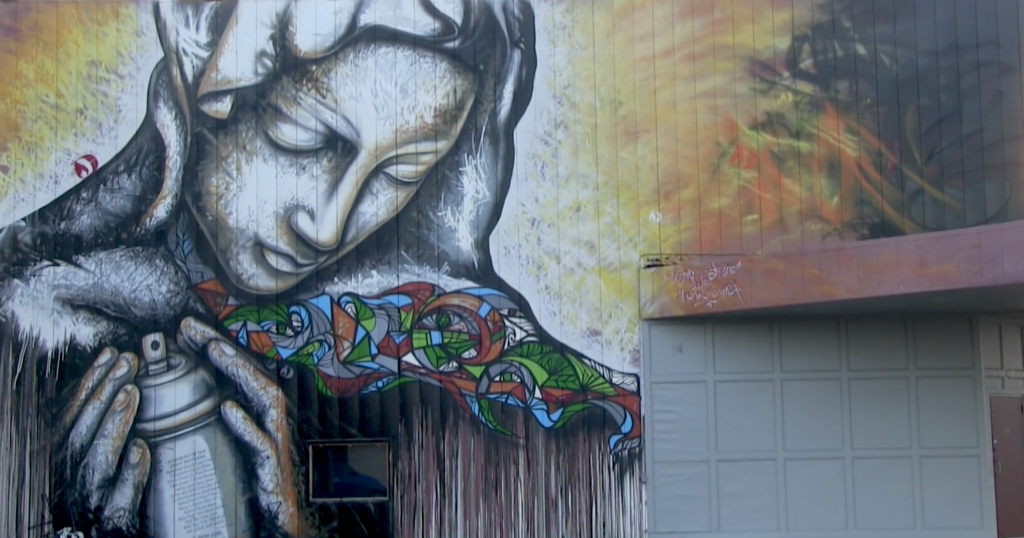
Graffiti is an expressive and thoroughly polarizing art form often relegated to the sides of bridges, freight trains and narrow alleyways.
It may be indistinctive, crude and ugly – a manifestation of the bleak and unrelenting hand of fate. Sometimes it is the exasperated and confused projection of a person’s suburban dysphoria. More often than not, however, it is a beautiful and captivating message to the world at large, a culmination of paint, sweat and tears. Whether it takes the form of an avant-garde exploration of the artist’s subconscious, a boisterous, colorful mural or a sharp-witted social commentary, graffiti explores a canvas vast and varied, hearkening back to ancient times when the walls of a cavern were a means to explore one’s own creative spirit.
As our culture has evolved, so has the public perception of graffiti. Laws were established to protect property. Texas Penal Code Sec. 28.08 states that “a person commits an offense if, without the effective consent of the owner, the person intentionally or knowingly makes markings, including inscriptions, slogans, drawings, or paintings, on the tangible property of the owner.” For graffiti artists, there has never been a surplus of legal avenues through which to experiment and express their artistic vision the way only a graffiti artist can, but it shouldn’t be at the cost of a non-consenting party.
Often the artist incurs more than the cost of a few spray cans and a step-ladder. Weeding out these ne’er-do-wells does justice to the brick walls and crème facades, but who does justice to the artist whose craft is so sullied by minimization? Years ago one name attached to such a plight was Jonathan Estes, a curator of the arts and owner of a tall, broad warehouse off the Gulf Freeway on Kingspoint Road.
The images emblazoned on the warehouse’s interior and exterior walls rendered like precious diamonds. On the facade’s left side, Salvador Dali’s visage existed in well-defined aerosol-spray. The right, a touching display – an elderly woman, her withered features a map of her long and fruitful life. These images evoked the warehouse’s divine purpose – it was a haven for artists with abject permission allowing them free-reign to do as they pleased.
In previous years, an annual event known as the Meeting of Styles was held there and many aspiring graffiti artists would flock to Kingspoint. Surrounding the warehouse and nearby strip center, the celebration would commence. Salvador Dali would disappear in a hazy mist, transformed into the Virgin Mary. The elderly woman would become an encumbered eagle. Different styles would come together, interlocking and canvasing great lengths throughout the day, until the entire area was new again.
The camaraderie and enthusiasm was palpable. In the swell of mirth and joy, a mythic gateway appeared through which the surly bonds of delinquency may be shed, or the unknown, unseen could finally rise and take form in a space fit for a king. In the deep swath of urban misfortune, this fixed point of inspiration and acceptance served a noble purpose.
Many of these artists gained a following and professional opportunities borne out of the hazy days at Kingspoint and would be less well-off had they not breached its large gate. These places exist to cultivate talent and create a safe space for graffiti artists to express themselves.
Of course, the warehouse is now owned by someone else, may Jonathan Estes rest in peace, and a fence was thrown up to keep people out. Gone are the action shots of Spider-Man as he quarrels with Green Goblin, the portraits of indigenous people of the Americas, the magnificent, swirling patterns. The sides and back wall are now relegated to a thick, white layer of paint, however, the facade retains a glimpse of the artistry that came before. The Virgin Mary serves as a landmark for the business while a second mural serves as a metaphor for the artists themselves – an eagle, a ball-and-chain affixed to its claw, against a pastel blue sky, unabated and filled with determination.
Graffiti artists see the world as a canvas and endeavor to explore it, satchel of spray paint and step ladder in tow. The warehouse was one example, but there are other sites that legally carry on this spark of rebellion. Seek out such places and covet them; they are sacred and carry on a tradition harkening back to the Native American tribes that once roamed pre-colonial America, to the ancient Egyptians whose captivating murals give great insight into the society that bore them, to the Paleolithic cave paintings of Lascaux.
[youtube http://www.youtube.com/watch?v=OClR1VXJjlU&w=730&h=485]

